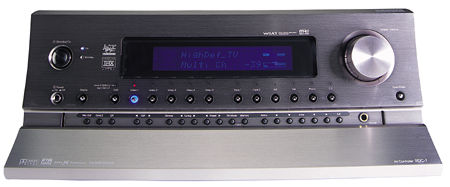Integra Research RDC-7 Preamplifier-Processor Page 2
Vinyl Siding
After my original review of the RDC-7 was published, all of our turntable-listening readers—both of them—questioned us about the sound quality of the Integra's phono input. One even accused me of negligence, despite the fact that SGHT doesn't generally evaluate phono preamps. But since some of my music collection is contained on those ancient, 12-inch, nondigital discs known as "LPs," I decided it was time to re-investigate analog playback. Michael Fremer suggested the Graham Slee Projects Gram Amp 2 SE as a reference comparison phono preamp. A friend lent me his Rega Planar turntable for a few weeks, along with a Linn LV X tonearm and Goldring 1042 cartridge.

Unfortunately for the RDC-7, I began with the Gram Amp 2 SE and was immediately spoiled. There's a chance that the Gram's capacitance loading is closer to matching the Goldring cartridge, but the Integra's specs don't include this value. The RDC-7's phono stage sound quality was good, but it lacked the Gram's rhythm and pace. The horns didn't have the same fullness, and cymbals lacked personality. I've heard drummers rhapsodize about the unique characteristics of different types of cymbals; I'm sure they would be able to hear those differences more easily with the Gram.
The Gram Amp 2 demo unit will have to stay in my studio—after this experiment, I am decidedly back in the vinyl camp, and most surround processors don't include a phono preamp. The one built into the Integra Research is better than none, but vinyl lovers would do well to invest in something like the Gram—or better—if their vinyl rig warrants it. I'm not sure I want to know how much better vinyl playback can get; I can afford only so many obsessions. [Information on the British-made Graham Slee Projects preamps—no connection with tonearm manufacturer Graham Engineering—and their US importers can be found at www.gspaudio.co.uk/analogue_audio_products.htm. The Gram Amp 2 SE, designed for high-output cartridges, sells in the US for approximately $300.—TJN]
Luddite Love
Devotees of 2-channel analog will love engaging the RDC-7's Direct button, which passes the 2-channel signal directly to the volume control without leaving the analog domain. In the minds of these folks, this results in no nasty digitizing of the signal, as in many other surround preamps. Toggling to Stereo, the other 2-channel playback mode, converts an analog input to digital, enables the RDC-7's bass and treble controls, and engages the subwoofer. But the analog fans are right: It also degrades the sound quality (which I'll discuss in more detail shortly). So much for digital perfection.
The upside of the Stereo mode is that it makes the Integra's digital upsampling function available for the analog input, an option that was not available in the original version (which upsampled only digital inputs). In upsampling mode, the RDC-7's digital sampling circuitry operates at 88.2kHz instead of CD's standard 44.1kHz rate, and it brings the sound quality closer to analog Direct mode. (A 48kHz-sampled digital input is converted to 96kHz, but analog inputs can be upsampled to only 88.2kHz.) The higher rate clearly sounded quite a bit better than conventional 44.1kHz playback, with much more detail and coherence, especially on instruments with strong high-frequency overtones, such as cymbals and plucked guitars.
Switching between Direct and upsampled Stereo with all other functions switched off allowed me to compare an analog bypass input with the upsampled digital version of the same source—the best digital option available in this unit. For this test, I used the turntable/Gram preamp, discussed previously, as the analog source. Clearly, analog Direct mode had smoother transitions in loudness. When subtle changes in sound level occurred, as in the violin solo in the second movement of the Spring concerto from Vivaldi's The Four Seasons (LP, Denon OX-7174-ND), the analog Direct audio flowed more naturally. The digitally upsampled sound was slightly but definitely overemphasized when the violinist changed the bow's direction on the strings. The pauses between long strokes were simply smoother when the signal remained in the analog domain. These subtle but obvious improvements will be immediately noticeable to analog fans—as long as the rest of the system doesn't obscure such details.
Enthusiasm Earned
Integra Research has even improved on a few of the RDC-7's shortcomings, one of which I failed to mention in the original review: Instead of the fixed 80Hz subwoofer-crossover point of the THX standard, the new RDC-7 has five user-selectable presets, ranging from 40 to 120Hz.
All of these enhancements—available not only to new buyers but to original owners as well—have bolstered my belief that Integra's promise to provide upgraded firmware as warranted by technological advances was anything but empty. And there's still an unused hardware slot on the backside of the unit, which provides even more room to grow.
The Integra Research RDC-7 is a product of good thinking and thorough engineering. My enthusiasm was justified nearly three years after its introduction; the RDC-7 earns its keep. Sure, it now costs $500 more, but its overall performance and excellent ergonomics keep it near the head of the pack.
- Log in or register to post comments











































